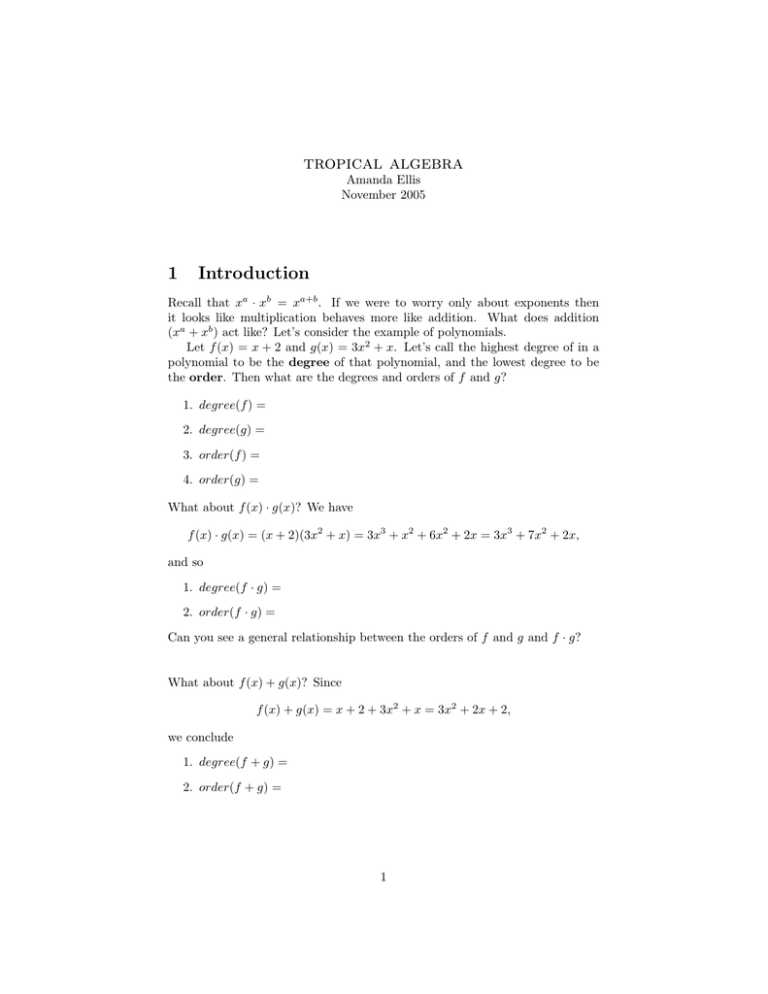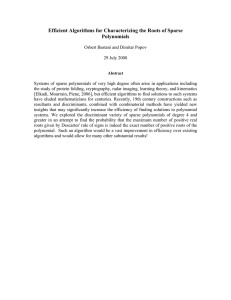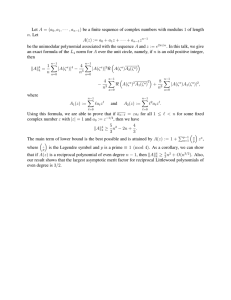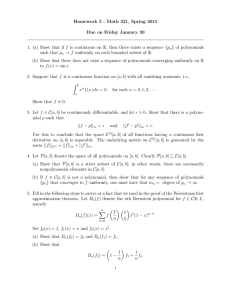tropical algebra 1 Introduction
advertisement

tropical algebra
Amanda Ellis
November 2005
1
Introduction
Recall that xa · xb = xa+b . If we were to worry only about exponents then
it looks like multiplication behaves more like addition. What does addition
(xa + xb ) act like? Let’s consider the example of polynomials.
Let f (x) = x + 2 and g(x) = 3x2 + x. Let’s call the highest degree of in a
polynomial to be the degree of that polynomial, and the lowest degree to be
the order. Then what are the degrees and orders of f and g?
1. degree(f ) =
2. degree(g) =
3. order(f ) =
4. order(g) =
What about f (x) · g(x)? We have
f (x) · g(x) = (x + 2)(3x2 + x) = 3x3 + x2 + 6x2 + 2x = 3x3 + 7x2 + 2x,
and so
1. degree(f · g) =
2. order(f · g) =
Can you see a general relationship between the orders of f and g and f · g?
What about f (x) + g(x)? Since
f (x) + g(x) = x + 2 + 3x2 + x = 3x2 + 2x + 2,
we conclude
1. degree(f + g) =
2. order(f + g) =
1
Can you again see a general relationship between the orders of f and g and
f + g?
What is the point of all of this? If we are only worried about what happens
to the exponents of expressions like f and g when they are multiplied or added
together, then it turns out that multiplication really looks like addition, and
addition really looks like taking a minimum or a maximum. We are just going
to stick with minimums for the rest of the time (but you could just as easily do
all of this for maximums).
Let’s actually formally define our new tricks for multiplication and addition,
they will be called tropical multiplication and tropical addition.
ab=a+b
a ⊕ b = min{a, b}
The above set of rules defines min-plus algebra, also called tropical algebra.
To warm up, let’s make sure we know how this actually works.
1. 3 1 =
2. 3 ⊕ 1 =
3. −1 ⊕ [5 (3 ⊕ 1)] =
4. −1 ⊕ [5000 (300 ⊕ 100000)] =
Given these new operations, it’s natural to ask to what extent they obey the
usual rules of arithmetic. This is taken up in the next few sections.
2
Basic properties
The usual operations of arithmetic (+ and ·) are commutative, and it’s easy
to see their tropical counterparts (⊕ and ) are as well. Associativity of is
obvious
a (b c) = (a b) c,
since it holds for +. It requires just a moment’s more thought to check that the
operation ⊕ is also associative,
a ⊕ (b ⊕ c) = (a ⊕ b) ⊕ c.
A slightly trickier one is the distributive law. Is it always true that
a (b ⊕ c) = (a b) ⊕ (a c)
for all a, b and c? Try a few examples and decide for yourself.
2
3
Identities
In regular arithmetic, if a is some number then what is a · 1? It’s a, of course.
This is because 1 is the multiplicative identity, which is to say that multiplication
by 1 returns what you started with. In tropical arithmetic, is there a number
like this?
If 3 a = 3, then 3 + a = 3. So a = 0.
Does this work for every number (not just 3)? If so then we would need x0 = x
for every x. Is it true? Yes, of course it is. The conclusion is that with respect
to , 0 behaves like 1 behaves with respect to ordinary multiplication:
a 0 = a for all a.
It’s natural to ask the corresponding question for the ⊕ operation. Is there a
tropical additive identity? A moment’s thought shows that with respect to ⊕,
∞ behaves like 0 behaves with respect to +:
∞ ⊕ a = a for all a.
4
Inverses
In regular math every number has an additive inverse: For every real number
a there is another number −a so that a + (−a) = 0 Also, every number has an
multiplicative inverse: For every nonzero number a there is a number a−1 = a1
so that a · a−1 = 1.
We can ask the same questions for ⊕ and . Let’s start with . Recall that
in the previous section 0 is the identity element for . They question is thus:
given any a, can we find another number (say b) so that a b = 0? This is
easy since a (−a) = 0. So the -inverse of a always exists and it is always
−a. In fact, for this reason, it is sometime convenient to write a−1 = a1 = −a
in tropical arithmetic.
Can we find inverses for ⊕? Since we decided that ∞ is the identity for ⊕,
the question becomes: for all a does there exist another number (say b) so that
a ⊕ b = ∞? You decide.
3
exercises 1
Using the rules of tropical arithmetic discussed above, find all possible values of
x which satisfy the given equations.
1. x 2 = 3
2. x2 2 = 14
3. x2 x = 9
4. x ⊕ 2 = 1
5. x ⊕ 2 = 2
6. x ⊕ 2 = 3
7. For x ⊕ 2 = a, can you find a general way to solve for x in terms of a?
8. x2 ⊕ 3 = 1
9. x2 ⊕ 3 = 3
10. x2 ⊕ 3 = 5
11. For x2 ⊕ 3 = a, can you find a general way to solve for x in terms of a?
12. x2 ⊕ x ⊕ 1 = −1
13. x2 ⊕ x ⊕ 1 = 0
14. x2 ⊕ x ⊕ 1 =
1
2
15. x2 ⊕ x ⊕ 1 = 1
16. x2 ⊕ x ⊕ 1 = 2
17. For x2 ⊕ x ⊕ 1 = a, can you find a general way to solve for x in terms of
a?
18. For x (x ⊕ 1) = a, can you find a general way to solve for x in terms of
a?
4
5
Graphing tropical polynomials in one variable
A tropical polynomial is (just as you would expect) any function of the form
an xn ⊕ an−1 xn−1 ⊕ · · · ⊕ a1 x ⊕ a0 ;
(1)
here each ai is any real number and
n
n
x
z }| {
= x ··· x.
Since it causes no confusion in practice, from now on we will simply write xn
instead of xn .
Notice that in order to interpret the expression in (??) properly we use the
usual conventions that multiplications (i.e. operations involving ) should be
performed before additions (i.e. operations involving ⊕).
The main point of this section is to understand what the graph of a polynomial f (x) can look like. We start with the simplest case,
l(x) = a x ⊕ b;
for reasons that should be clear, this is called a tropical line. By definition
l(x) = min{a + x, b},
or, more explicitly,
(
a+x
l(x) =
b
if x ≥ b − a
else.
For the purposes of drawing a graph, let’s assume b > a ≥ 0. Then the graph
of l(x) looks like
y
6
b-
-
a
- x
6
b−a
Let’s try one more example together. Consider the tropical parabola,
p(x) = a x2 ⊕ b x ⊕ c.
More explicitly, we have
p(x) = min{a + 2x, bx, c}.
5
(Make sure you understand this!) Again for the sake of drawing a picture, let’s
assume c − b > b − a. Then we can quickly arrive at the following graph,
y
6
c-
-
b
a
- x
6
6
b−a
c−b
The following set of exercises deal with the graphs of general polynomials.
exercises 2
Graph the following expressions
1. 1 x2 ⊕ 2 x ⊕ 5
2. 0 x2 ⊕ 2 x ⊕ 5
3. What happens when b − a > c − b? Try graphing
(a) −1 x2 ⊕ 2 x ⊕ 5
(b) −1 x2 ⊕ 5
What does this mean about the uniqueness of graphs of polynomials?
4. Graph the following (for part (c) you may need to simplify the expression
using tropical arithmetic first)
(a) x ⊕ 5
(b) 2 x ⊕ 1
(c) (x ⊕ 5) (2 x ⊕ 1)
What do these graphs have in common? What do you think this means
about the products of tropical polynomials?
6
6
Roots of polynomials
Recall that in regular algebra, the roots of a polynomial
an xn ⊕ an−1 xn−1 ⊕ · · · ⊕ a1 x ⊕ a0 ,
are the solutions to the equation
an xn ⊕ an−1 xn−1 ⊕ · · · ⊕ a1 x ⊕ a0 = 0.
This method of finding roots doesn’t work in tropical algebra. Consider the
polynomial equation
x ⊕ −1 = 0.
Does this equation have any solutions? No! (Since the minimum of something
and −1 must always b less than or equal to −1, and therefore can never be 0).
Instead, let’s define the roots of a polynomial to be the breaking points in
the graph, or more specifically, the place on the graph where the minimum of
all monomials is achieved twice. So, if we consider the quadratic polynomial we
used earlier, whose graph looks like
y
6
c-
b- a
6
b−a
-
- x
6
c−b
Then the roots are x = b − a and x = c − b. Recall that the polynomial was
given by
a x2 ⊕ b x ⊕ c = min{a + 2x, b + x, c}
The places where the minimum could be achieved twice are where
a + 2x = b + x ≤ c, or
a + 2x = c ≤ b + x, or
b + x = c ≤ a + 2x.
7
After solving for x we get
x = b − a, if 2b − a ≤ c, or
1
1
x = (c − a), if c ≤ b + (c − a), or
2
2
x = c − b, if c ≤ a + 2c − 2b.
Recall that when we started the problem we decided to assume that b−a < c−b
which is the same as 2b − a < c and c < a + 2c − 2b, but is the opposite of
c < b + 21 (c − a). This tells us that the first an third choices should have shown
up as roots of our polynomial, but not the second. So, you can find the roots
algebraically as well.
exercises 3
Find the roots to all of the polynomials in Exercises 2.
1. 1 x2 ⊕ 2 x ⊕ 5
2. 0 x2 ⊕ 2 x ⊕ 5
3. What happens when b − a > c − b?
(a) −1 x2 ⊕ 2 x ⊕ 5
(b) −1 x2 ⊕ 5
4. (a) x ⊕ 5
(b) 2 x ⊕ 1
(c) (x ⊕ 5) (2 x ⊕ 1)
Now let’s try to find the roots of polynomials with two variables, x, and y.
Consider the polynomial
a x ⊕ b y ⊕ c = min{a + x, b + y, c}
In order to solve this one geometrically, we would need to be able to graph
three planes in three dimensional space. That is we would want to look at z = c,
z = a + x and z = b + y. Instead, let’s find the roots algebraically. Remember
that the roots in this sense are where the minimum of the three monomials is
achieved more than once. This can happen in three ways:
a+x=b+y ≤c
a+x=c≤b+y
b+y =c≤a+x
8
After simplifying, this is the union of three rays:
y = x + (a − b), x ≤ c − a
x=c−a y ≥c−b
y =c−b x≥c−a
The picture of this looks like
6
b(c-a,c-b) exercises 4
Find the roots of the following polynomials
1. 5 x ⊕ 4 y ⊕ 6
2. x y ⊕ y 2 ⊕ 1 y ⊕ 0
3. x y ⊕ −1 y 2 ⊕ x ⊕ y
4. x y ⊕ y 2 ⊕ x ⊕ y
5. 1 x2 ⊕ x y ⊕ 1 y 2 ⊕ x ⊕ y ⊕ 1
9








